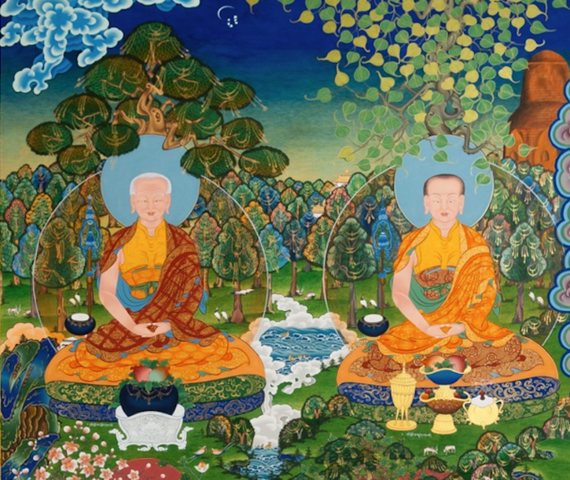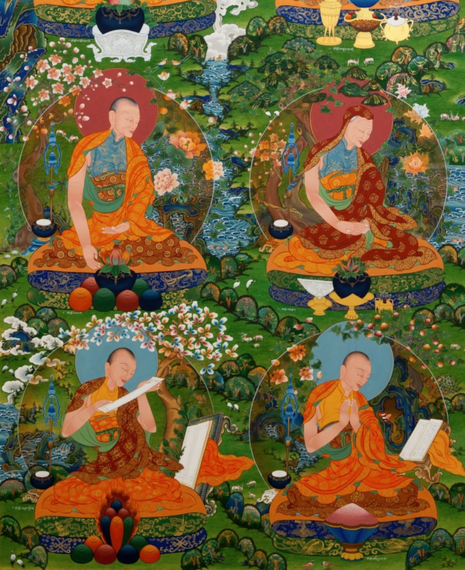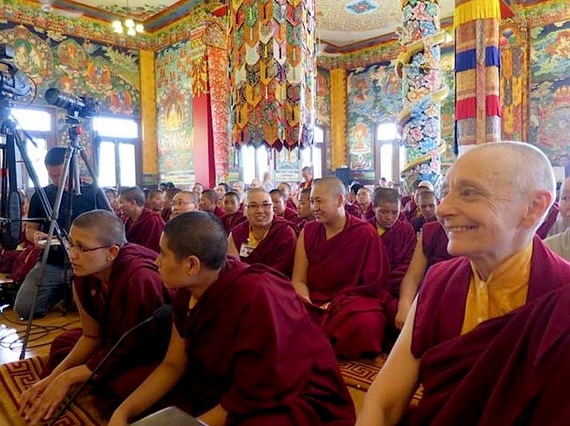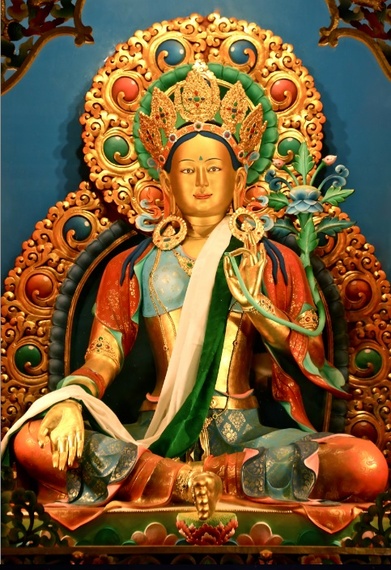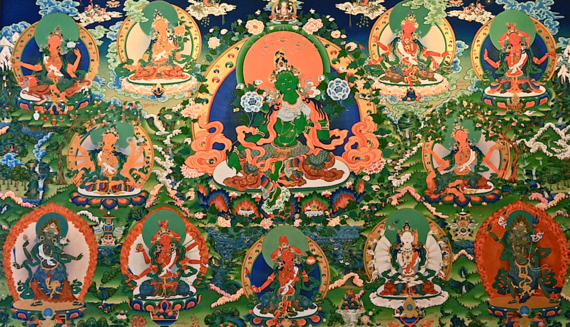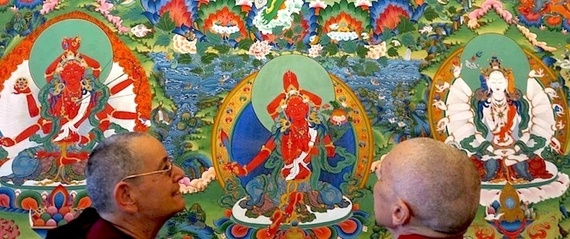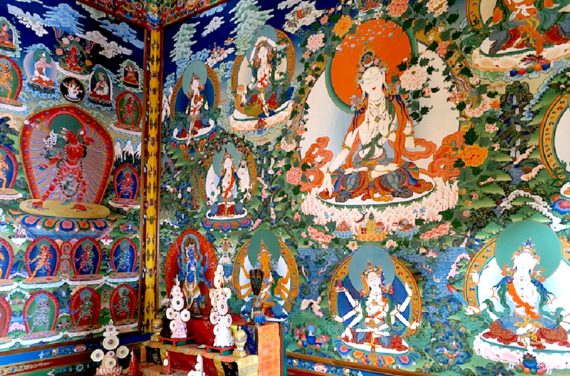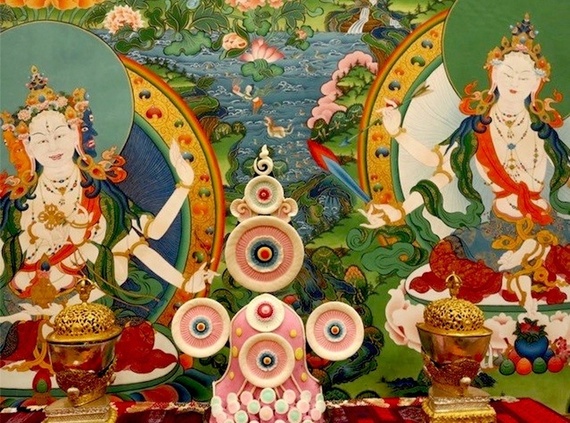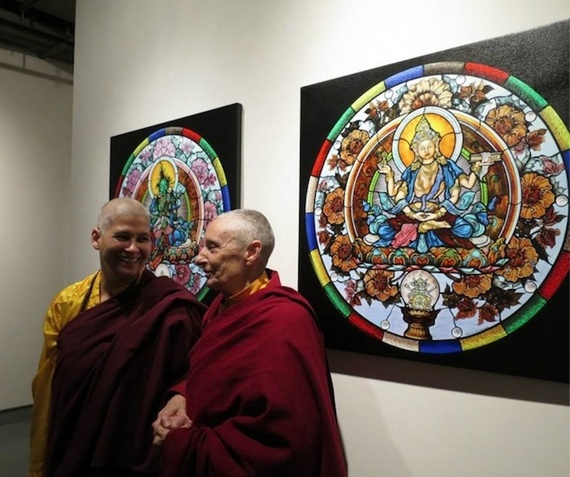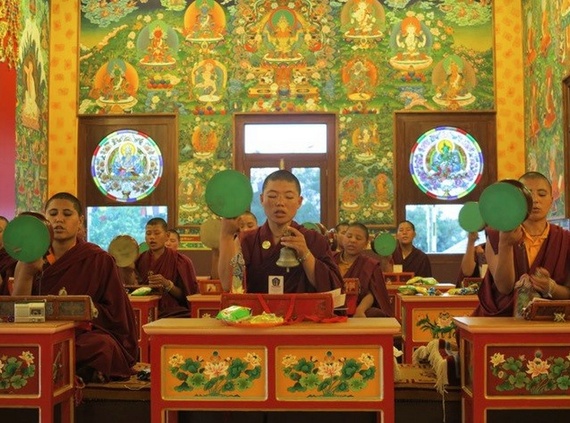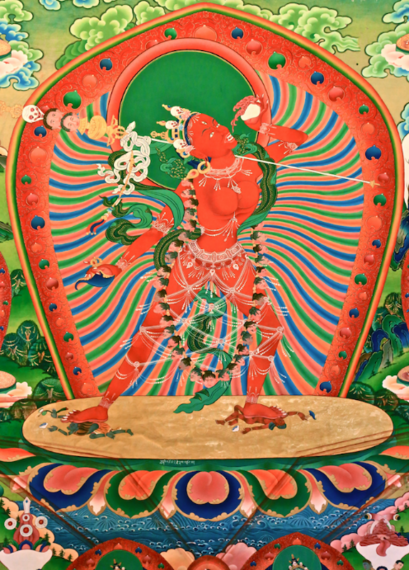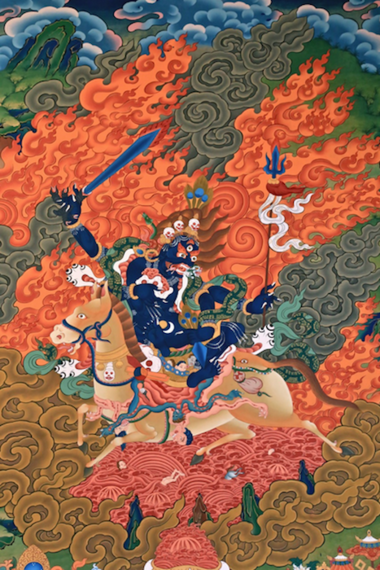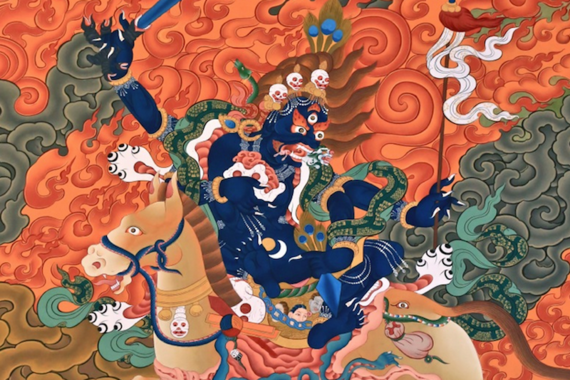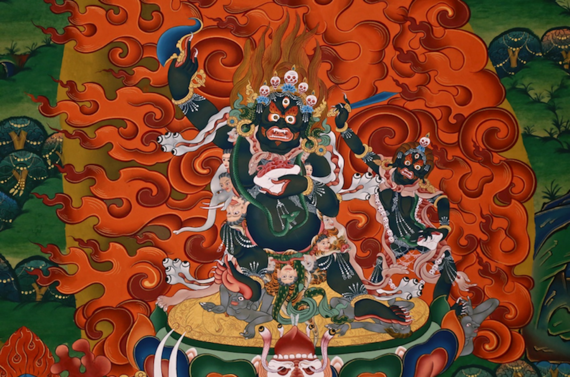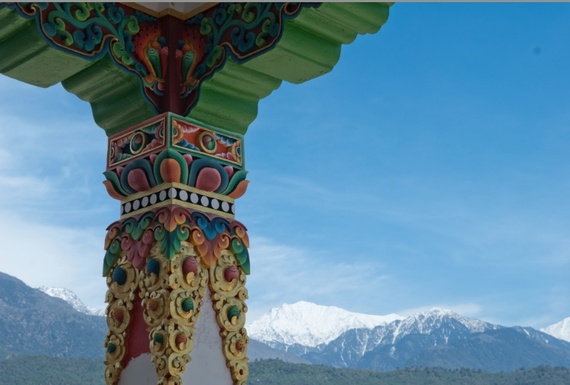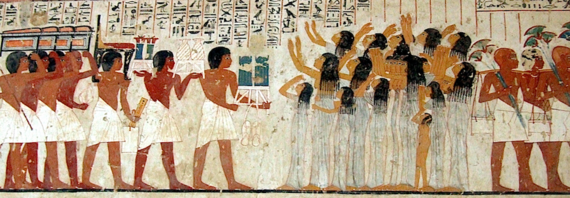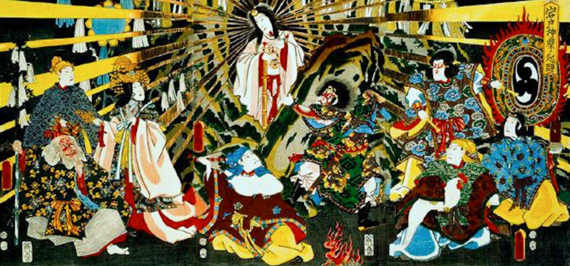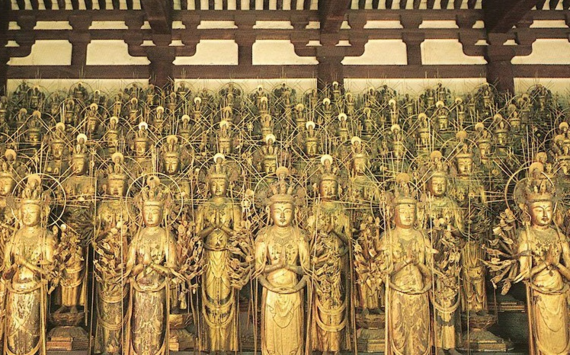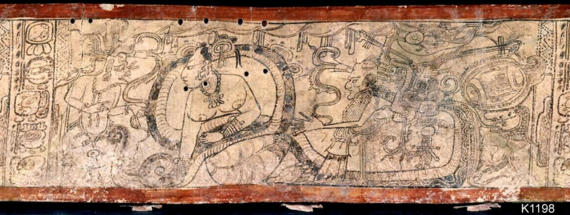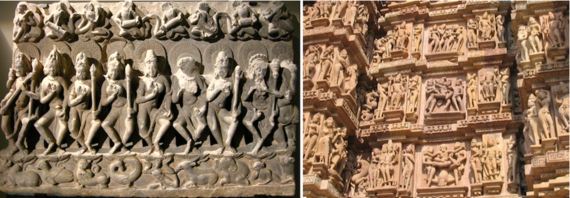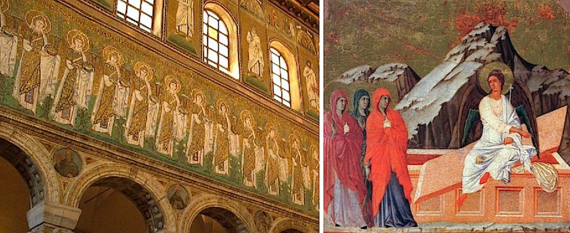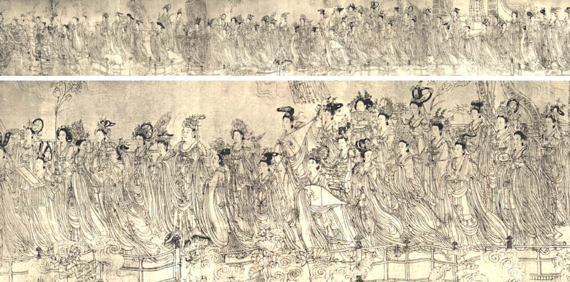In mid-January the British-born Buddhist nun, Jetsunma Tenzin Palmo -- the closest thing we have to a Thomas Merton figure today -- spoke before a sold-out audience at the Rubin Museum of Himalayan Arts in Manhattan. The nun of 50 years is known not only for having spent twenty years of her life meditating in a cave, but for her founding of the Dongyu Gatsal Ling Nunnery for young Buddhist nuns in the Kangra Valley of the Indian state Himachal Pradesh, a two-hour drive from the Tibetan exile community of Dharamsala. The topic was Jetsunma's approach to visualization in meditation and the overall place of art in its embodiment and enhancement of dharma.
The audience revealed themselves in their questions to be largely enthusiastic Americans, many no doubt who embrace or are considering embracing Buddhism as the guiding principle for their lives. But there were also those like myself who are neither Buddhist nor a practitioner of meditation but were there because the visualization in question regards the art of Himalayan Buddhism -- or Tibetan Buddhism as it's more often, if narrowly, called. In my case, as a student of world cultures and in particular of belief systems, mythologies and mythopoetics, I'm interested in why a faith and artistic sensibility that is so spectacularly mythological in an archaic sense has such an appeal to so many Americans brought up in a culture of modernism. Most of the new Buddhists I meet are highly rational individuals, yet they meditate seriously and serenely with the aid of supernatural, even monstrous figurative, sometimes barely humanoid, iconography that include primary- and secondary-colored entities, some with six or eight arms -- buddhas, bodhisattvas, yogis and hybrid beings, some even gods and goddesses -- that resemble characters we today see in comic books and screen animations. Even in the centuries of their elaboration in Hinduism and Buddhism one-to-two millennia ago, they must have seemed too unbelievable by the more rational earthbound devotees of Buddhism, especially those concerned with the philosophy of ethics and compassion, to be considered as anything more than an artist's ingenious escape from the mundane pictorial constrictions of ordinary life.
Himalayan Buddhism is particularly possessed of a hyper-magical pantheon of allegorical protagonists and antagonists especially difficult to reconcile with the more Zen-like principles of many Mahayana Buddhists and which place value on conceptual, perceptual and physical emptiness, stillness, and even an art of poverty over the wealth of chromatic and gilded embellishments of the Himalayan art of spirituality. The Himalayan taste for vivid, some might say electric color, combined with the erotism of certain of its sculptures and paintings, seems especially out of sync with the Zen-like minimalism of its more famous artist and intellectual practitioners. I'm referring to such seminal figures in the arts as Phillip Glass, Meredith Monk, Laurie Anderson and scores of others like them. Then, too, it is to it's credit that Himalayan Buddhist devotional art and meditative visualization, like much of the Indian art from which it derives, welcomes the erotic character in art. South-Asian civilization as a whole requires no Freud or Bataille to instruct them on how and why erotism cannot be deleted from the history of religion, however much the world's othodoxies would wish it away. In Himalayan sacred art, erotism, like all other visualizations, activates the mind's eye -- the eye of inward apperception -- to transform our external perception of our own presumed singular and disparate realities into bridges to endless other individualities that together build the continuity that binds us as a whole.
But discussions of magical realism, surrealism and the art of spectacle and erotism are not what concerns the impressively serene and pragmatic Jetsunma, as she is called by everyone to her apparent satisfaction. Even when discussing a topic like visualization, she remains focused on the liberation attained in the process, not the abstract or structural, the psychological or the mystical methods and effects. Her priorities are rooted in the social implications of Buddhism, which is attested by her early life focus. It was at the age of 20 in 1964 that she became one of the first Westerners to be ordained as a Buddhist nun. Thanks to at least two biographies written about her since, she has acquired the reputation and recognition of delivering hard financial and concrete results in a career devoted to the advancement of young women. Hers is the kind of character that proved itself capable of navigating through all the cultural, ideological and political differences that obscure right living, or at least the pathways to right living that manage to run through the bureaucracy and prejudice characterizing life in the northern border region of Himachal Pradesh, India.
We should remember that despite the region's idyllic, unspoiled scenery, this is a territory bordering the new Chinese Tibet, a country being gutted of its cultural legacy and governed with an abrasively hostile Chinese colonialism intent on the complete assimilation of Tibet within the Chinese cultural landscape. Authorities here must also contend with the insidious trafficking of young girls that transgresses India's borders with Bhutan and Nepal, two nations from which several of her young nuns have emigrated to seek out the DGL sanctuary. Yet despite the region's political and legal elusiveness and complexity, somehow this woman who spent fifty years practicing meditation, has raised the funding to build and maintain a bricks-and-mortar monastery for women largely of Himalayan descent. The name 'Dongyu Gatsal Ling' is apt, meaning as it does 'Delightful Garden of the Authentic Lineage'. Yes, ideological competition interrupts even the serenity of Buddhists, at least those caught up with the rivalry of lineages both between and within the Theravada and Mahayana schools. Even Jetsunma isn't above showing loyalty to the Drukpa Kagyu lineage to which she belongs. With "Druk" meaning dragon, the lineage can be seen literally weaving throughout the monastery's decoration and art in the sculpted and painted dragons that twist around columns of the DGL temple.
While Jetsunma is helping the Tibetans in exile to preserve the legacy of their traditional sacred art -- for which she has commissioned the renowned master Tibetan thangka painter-in-exile, Kalsang Damchoe, the founder of the Kalsang Tibetan Traditional Art of Thangka Painting studio in India -- the charismatic nun is attracting attention for what she and Mr. Damchoe are introducing to the Himalayan tradition while setting the art of the DGL sanctuary apart. And that is the mythopoetic radicalism of the art installed -- 'mythopoetic' meaning the making of new myths. For over the last few years, Jetsunma has commissioned the creation and installation of art work that emphasizes the power of the female principle and presence in art, life and devotion.
I should here clarify that my discussion of this history in mythological terms does not mean that I am using the term 'myth' as synonymous with 'untruth' or 'fiction', as is mistakenly done in colloquial usage. Myth is a language and principle, or complex of principles, that cannot be deemed true or false, fact or fiction. Myth is another word for a model or an idea of things, rather than a description of things in the world. More concretely, myth is a model for living, not a mirror of life. And in this sense Buddhist mythopoetics is the making or remaking of myths modeling right living in contemporary society. In the DGL nunnery the myths of Tara, Vajrayoginī, Mahākāla, and their many aspects, stand in for living qualities within us all, yet which require enhanced living (whether through meditation, right living, compassion, charity, activism, and ideally all of the above). Even the wrath of a deity such as Mahākāla has a right place when considered as a protection of the righteous and downtrodden -- which is why Mahākāla appears prominently in the murals at the DGL shrine.
It was apparent that the seasoned Buddhists in the audience at the Rubin Museum on that freezing January night were as unprepared as I for the mythopoetic character of the art being introduced to them. For no one who has studied Himalayan art would expect the brand of feminism that Jetsunma introduced quietly and without polemics in the slide projections. Jetsunma herself has expressed the character of her mythopoetics.
"Our temple is at the heart of the Dongyu Gatsal Ling Nunnery Since this is a Nunnery, the inner decoration of the temple reflects female embodiments of Enlightenment - Tara, Vajrayogini and so on - and this is especially emphasized in the exquisite murals around the walls and the rounded stained glass windows. There are walls dedicated to senior nun saints surrounding Shakyamuni Buddha and Mahaprajapati who was the Buddha's stepmother and the first nun. These are rarely portrayed in Buddhist art. Also there is the great yogin Milarepa surrounded by his female disciples. When people enter they immediately feel a sense of peace together with gentle but powerful feminine energy: they feel awed and uplifted."
Perhaps we all should have expected an espousal of feminism to come from Jetsunma. After all, she became a Buddhist nun just when her native England and the West as a whole was undergoing a radical feminization of society. Why shouldn't feminism now be brought to fruition among Buddhists? They are, after all, among the most civilized and democratic peoples the world has known, and it should be no more remarkable to witness feminism manifest in a Himalayan sacred art that has long depicted female deities, yoginis, and bodhisattvadevi, than it is in the art of the West. Yet remarkable it is, and for the reason that the historical characterization of the very entities that Jetsunma commissions for her art were originally designed to placate the patriarchal sensibility written into and legislating Buddhist social structures.
There is also the revelation for this writer that my own expectation not to find feminism in such a traditional religious environment was an impediment arising from my own eurocentric world view. And once I realized this, there was nothing to keep me from seeing feminism aligning with Himalayan Buddhism and its art. For despite being European, eurocentrism by all appearances did not keep Jetsunma from finding the heart of feminism beating within the very center of the Buddhist practice of meditation. But of course she would find it there. For the discovery, spread and eventual ubiquity of meditation is arguably the first democratic revolution in history. The world has forgotten that meditation was developed by middle-class Hindus who posed themselves in defiance of the self-aggrandizing practices of the Brahmin oligarchy and priests in India some three thousand years ago. They had discovered that the simple practice of looking within oneself liberates the individual -- any and all individuals -- from the dictates of an imposed authority over a spirituality that is for everyone to legislate for herself through meditation. And one key to that spirituality is the visualization of the self possessed of all the attributes of a buddha and a god. It only follows that for the individual accustomed to identifying as feminine in gender to naturally depart into her visualization of divinity from a female avatar.
What's important here for humanity as a whole (and what we who demand a more avant-garde and abrasive art of dissent have to come to terms with), is that the new Himalayan convent that Jetsunma has built and outfitted with art is the kind of cultural environment that is necessarily traditional and indigenous, and thereby welcoming to the young novitiates who gather everyday to study, meditate and perform the rituals around which the Buddhist monastic calendar revolves. Most importantly, the nunnery that receives these women of a Himalayan heritage -- many who flee the many faces of East- and South-Asian authoritarianism and the subsuming corporate globalism which together threaten to annihilate their heritage -- supplies them with an iconography of resilient and active feminine character aspects to reinforce their conviction and practice as women students, professionals, artists and Buddhists.
of her designs in the exhibition, TENDREL - རྟེན་འབྲེལ - Interconnections, curated by Chrysanne Stathacos, and installed permanently at the
Dongyu Gatsal Ling Nunnery, as seen in the photo immediately below.
Jetsunma's project is no less than one of liberating the feminist aspects that lay dormant within these myths and icons for centuries. A good portion of the figures that decorate the temple and study halls derive from the 4th century CE, when the feminine principle first gains acceptance in the Mahayana traditions that Himalayan Buddhism partakes in. It was around the 6th century that the goddess Tara, who dominates the DGL temple in the number of her aspects represented, appears as the region's female personification of Kannon, who was before this always represented as male in India and China, where he was only just being introduced. There was a feminist activism attendant to their assimilation into mainstream society even in these early centuries, as Kannon in Japan and China very quickly became represented as a female bodhisattvadevi and after that as the Goddess of Mercy and Harmony. Throughout Buddhist Asia, there was a renewed assimilation of the female principle that originally departed from, or was conferred by, the male bodhisattva and deity. For example, Tara's origins have her as no more than Kannon's wife.
by artist Tsunma Jamyang Donma of Yulokod Studios.
For this viewer, the renewed representation of real women grounded in history yet neglected or underestimated by historical accounts is the most substantial contribution to the visualization of women active in Buddhism. The six figures pictured at the beginning of this post are attributed with being historical, that is if we count the legendary Mahapajapati Gotami, the Buddha's stepmother and aunt who is attributed with being the first woman to receive ordination from the Buddha. On the walls of the nunnery we find her accompanied by five other nuns, the first to have followed her example.
Are Jetsunma, her nuns and artists achieving something truly radical and unprecedented at DGL? In the context of tradition-laden India, Nepal and Bhutan, they are. For however many exceptional women in the region of the Indian-Pakistani-Bangladeshi subcontinent have emerged in recent decades as national and international leaders, it is their very exceptionalism that informs us that not enough women benefit from their example because inspiration without means are inert for not being able to sustain life through the kind of bond the mutually beneficial partnerships produce. Women require the opposite of exceptionalism to build a society in their image. They need women in great numbers to bring change. Jetsunma's emphasis on the female form in meditation is productive because she also supplies the means -- the housing, clothing, food, books -- the protection -- that the young women cannot find on their own amid the conservative male populace and who are making headlines regularly for their treatment of women. We need only recall the Hindu mobs in India who burned down the movie sets for Deepa Mehta's Academy-award nominated film, Water. And this for a story that did no more than plead for a humanist and compassionate end to the archaic Bhahmin practices of grown and often old men taking child brides; of forcing widows into isolation and abandonment upon their husbands' deaths, and the desperate prostitution to which the most desperate resort.
Jetsunma herself has recounted obstacles imposed on her for her gender, "When I first came to India I lived in a monastery with 100 monks. I was the only nun... I think that is why I eventually went to live by myself in a cave... The monks were kind, and I had no problems of sexual harassment or troubles of that sort, but of course I was unfortunately within a female form. They actually told me they prayed that in my next life I would have the good fortune to be reborn as a male so that I could join in all the monastery's activities. In the meantime, they said, they didn't hold it too much against me that I had this inferior rebirth in the female form. It wasn't too much my fault."
In fact the gender bias has only made her more resolved to doing her part in ending it, "I have made a vow to attain Enlightenment in the female form - no matter how many lifetimes it takes".
Jetsunma in collaboration with her artists and donors are reversing the historical equation of gender prominence to bolster the confidence of her charges. With the exception of a handful of paintings and sculptures representing the Buddha and other male bodhisattva and yogis, such as Milarepa, who are significant in Buddhist history, the walls are covered and the niches filled with scores of women's sacred figurative imagery and statues overlooking the study and temple areas.
Given that the art of the DGL temple and monastery is of a traditional nature, it stimulates comparison with the visualization of women in the artistic traditions of the world's religions and faith systems in general, both those living and dead. Which is why I close this post with a range of iconography that have promoted and still promote strong feminine principles and presences to compare with the DGL iconography of deities, saints, bodhisattvadevis, yoginis, and real women religious.
--Special thanks go to Venerable Aileen Barry, assistant to Jetsunma Tenzin Palmo for the images and information regarding the Dongyu Gatsal Ling nunnery installations and the names and characterizations of the subjects depicted. And thanks to Chrysanne Stathacos and the Dongyu Gatsal Ling Initiatives for setting up the correspondences necessary for this article.
(For more on recent trends in the feminization of women's myth, see Women's Mythopoetic Art: Going Back to Start, Heroically, on Huffington Post. http://www.huffingtonpost.com/g-roger-denson/womens-mythopoetic-art-go_b_1772277.html)
Putting the DGL Nunnery Art In A Global Context: A Brief Comparative History of Women's Visualization in the Art of Religion and Ritual
Jetsunma Tenzin Palmo's feminist activism through art reminds us that the visualization of women and the feminine principle as a mode of ideology and pedagogy regarding sex and gender roles had enormous sway over the way in which women would be regarded by the faithful. The same art as well historically reflects the valuation and function of women both symbolically and pragmatically in a culture's day to day social and political enactment. Since the rise of modern feminism in the 19th Century, our attitudes about the power attributed to the feminine principle throughout history has altered our perception, if not our understanding, of the Paleolithic and Neolithic valuation of women expressed through the language and techniques of beautiful and captivating visualizations. In terms of religious politics, the so-called Paleolithic "Venus figurines," and to a lesser extent the trans-continental scatterings of stone ithyphallic sculptures, hillside carvings and cave paintings have famously informed the art and archeological theory of the last century despite that we have virtually no ascertainable knowledge concerning what the meaning of such Paleolithic and Neolithic art had to its makers. The archeological and anthropological debates that came to fruition in the 1960s over the power of the feminine generally and the Goddess cults specifically in Paleolithic and Neolithic societies has hardly validated any of our sex and gender theories one way or the other about these early populations despite sparking our imaginations and debates regarding sex and gender politics enough to make great strides toward securing parity at least in the most democratic and secular enclaves of the world. World religions, however, remain the sites of the fiercest battles over women's political ascendancy and reproductive rights. And yet, nations such as Pakistan and India, which bear some of the most conservative religious orthodoxies in the world, have seen the political ascendancy of women rivaling, if not surpassing, those in the democratic nations--but also rendering them just as targeted as men, if not more, for assassination.
If Jetsunma Tenzin Palmo's gentle feminist pedagogy and activism within the sphere of Himalayan and Indian Buddhist enclaves means anything to her followers, and to the broader global audience, certainly it is for reflecting how she will effect the faithful's ideas and attitudes toward women colleagues by example of the positive effects of assimilating women into the Tibetan Buddhist hierarchy. It is no small achievement, given that the entire relationship of matriarchy to patriarchy in the struggle to control religion is called down for account by her. And unlike in the West, Jetsunma's call for equal representation in the iconography of Himalayan Buddhism directly indicts the historical suppression and displacement of the Goddess faith systems by later male-centered religions. All of this may sound like abstract and academic arguments, but they in fact inform the ideologies and workings of religious lives, and their impact on the secular lives they contact and sometimes collide with.
What follows is a concise if generalized encapsulation of the representation of women's power and roles in the significations of religions living and dead and as evidenced by the attendant art and artifacts of their day. Most but not all had emerged with or after the rise of patriarchy in the Bronze Age Societies known the world over, with the earliest retaining a strong pre-Bronze Age goddess presence in the most powerful and renowned male-dominated pantheons.
Dynastic Egypt
No goddess is more all-encompassing than the Egyptian Goddess Nut, who is both the universe itself and the daily rebirthing and devouring of that universe that comes with the daily rise and set (the rebirth and death) of the sun. In the ceiling mural from the Tomb of Ramses VI (ca. 1143-1136 BCE), Nut is seen straddling the sky, with her body the border of the day and night skies. The path of the sun, depicted as a red disk, is also traced through the day and night skies as it is born from Nut's loins and travels along the length of her body to be swallowed in the evening. The empty solar barque returns beneath her body at night to begin the cycle again the next morning.
With such an all-powerful, all-defining and all-consuming goddess, it is a curiosity that women in Egyptian gradually lost their rights to reign as the state religion centralized around male-centered narratives and rituals (such as a yearly male masturbation ritual required of the Pharaoh by the cult of Osiris). Exceptional queens, such as Hatshepsut, did seize power and become pharaoh, and ordinary women citizens retained their right to inherit and own property throughout most the dynastic rules. Nonetheless, the lives of ordinary women are perhaps better documented by the art of Egypt's funerary culture than any other society in pre-modern history. And from such art we glean much about the division of labor along sex and gender lines, as seen immediately below.
Shintoism in Japan
Shintoism as we know it today is as much a modern invention as it is an ancient and disparate worship scattered around several localities with no centralized structure and even barely a group of deities shared by whole regions. What the many ancient and local Japanese worshipers did share was a devotion to nature spirits in general, and a deep respect for the feminine in nature that in many regions was equal in balance with the male principle in nature. It wasn't until after Buddhism was introduced to Japan in the 6th century CE that Shintoism became more centralized and common deities were agreed upon and renamed accordingly -- but only because they as well became shared with Buddhism. It wasn't until the Meji Restoration in 1868 set out on it's nationalistic agenda to establish an imperial faith entirely from those with exclusively Japanese origins and separated from the Chinese and Indian import of Buddhist deities, that Shintoism was distinguished and centralized. It is remarkable that at a time when the esteem for women was at its lowest in centuries that a relatively unimportant Shinto goddess was made the deity of the sun from which the Emperor and his family suddenly claimed descent and power. That Goddess, Amateras, is one of the few Sun Goddesses exalted in the sphere of world religions, however artificially and forcibly she was contrived by the state. In an effort to popularize her, Japanese artists were encouraged to promote her through their art. The newest national art sensation of the day being the ukiyo-e woodblock, it was ideally suited for making editions that could be widely distributed among collectors and thereby became the vehicle of Amaterasu's proselytization. The goddess was even counterpointed with a weaker male Moon God, not a consort but a benevolent brother accorded with less significant status -- a reversal of the trend over several millennia of installing a male sun god with a female moon consort. A debate has risen, however, whether Amaterasu's exalted status is the reflection of the status of women in the ancient hierarchies of Shintoism or if the deification of the female principle turns out to be a modern remnant of the 19th-century Meji restoration that just so happens to be in line with a feminist Shintoism.
Japanese Buddhism and the Goddess Kannon
Recent feminist historians have pointed out that the role of women in Japanese life and politics shifts radically with each successive rule, and with the attendant religion of the ruling class. The ebb and flow was chiefly between Japan's two dominant faiths, Shintoism and Buddhism, which taken together supplied Japanese women with a dual identity vacillating between a strong matriarchal line in Shintoism and an acquiescence to male supremacy under Buddhist hierarchies. But even this duality is not always clearly defined, as the freedom and self-reliance of women grew in periods after Buddhism had declined yet was recouping its ascendancy with the introduction of new revitalizing Buddhist sects inclined to grant women certain liberties. Women even became samurai in medieval Japan, although the restrictions concerning their ownership of property, wealth and political status under Buddhist rule remained tightly controlled by men. It was with the emergence of the Geisha in the Edo period and the widespread dispersal of the courtesan that the status of women became devalued, if perennially romanticized.
The centuries of Buddhism's ascendancy in Japan coincided with the extraction of a goddess of mercy and wisdom from what was formerly a male boddhisatva-become-god, Kannon. As with her counterpart, Kuan-yin, in China, Kannon was also thought to be the goddess of the Sea, for which she was visualized with a dozen or more arms in the fashion of such shell fish as the crab and lobster. But as a dozen arms seemed hardly supernatural enough for the spectacular nature desired of a supreme goddess, Kannon came to be embodied as The Thousand-Armed Kannon. In 1164, the Emperor Go-Shirakawa saw fit to build a temple for The Thousand-Armed Kannon. Known as Sanjūsangen-dō, the shrine is situated in the sacred temple city of Kyoto, and is distinguished not only with a giant wood and gilt statue of the thousand-armed goddess seated on a lotus leaf, but even more remarkably and aesthetically Zen-like with a thousand wood and gilt statues of Kannon in her human manifestation. With each statue appearing serenely composed and holding her two hands folded upward in the simultaneous greeting of peace and gesture of prayer, despite the apparent uniformity of the thousand statues, each one has been crafted individually to give it a distinctive face. It is a feature that has incurred the legend that if a devotee of the goddess looks long and hard enough upon the assembled mass of countenances, she will be rewarded in finding the face of her true love. On a more advanced Zen level, the meditative soul will come to know the harmony of oneness and unity to be found amid a sea of difference.
Meso-American Underworld Goddesses
In wishing to represent the sacred feminine principle of the American continents, there are as many manifestations of the sacred feminine as there are Neolithic societies, many of which manifest the goddess or female great spirit conflated with an animal or even a monstrous, composite form. In the southern North and Central American societies, the goddess appears as a snake woman (Yucatan and Gutamalan Mayan, pictured above) or a spider woman (Hopi), even a dragon woman (Aztec). Perhaps to compel her veneration with awe and respect, the goddess or spirit is sometimes conveyed as monstrous in her initial approach, yet mothering in her acquaintance. This could as well be a signification of her emergence from the underworld in association with the dead who are buried beneath the earth -- the habitats of spiders, scorpions and snakes. Then too she may take her form in an artist's spirit quest as induced through some ritual hallucinative.
The most accepted motive is that she is intended to ward off enemies. The archeologist Esther Pastory sees a warrior aspect in the monstrous goddess Chuacoatl at Teotihuacan (Mexico City). "Although I cannot prove this precisely, I sense that the Aztec goal was military glory and staving off the collapse of the universe."
The Mother Goddess Alliance and the Sacred Courtesans in Indian Hinduism
Hindu India places great emphasis on the Mother Goddess, whether benevolent as Parvati and Lakshmi, or wrathful and avenging, as Durga and Kali. Between the 4th and 12th centuries an abundance of sculpture appear throughout central and northern India assembling an alliance of mother goddesses as a powerful coalition force that became known as the dancing Sapti-Matrika -- seven mother goddesses. Yet even this powerful assembly that no mortal male would dare to offend was consolidated entirely for the male imperative. The motif here to be considered is that of motherhood, but a motherhood in deference to the father and patriarch. As one commentator put it, "The Matrkas emerge as Shakthis from out of the bodies of the gods: [the mother goddess] Brahmi form [proceeds from] Brahma; Vaishnavi from Vishnu; Maheshwari from Shiva; Kaumari from Skanda; Varahi from Varaha; and Indrani from Indra. They are armed with the same weapons, wear the same ornaments and ride the same vahanas and also carry the same banners like their corresponding male Gods do. Saptamatrka as a group indicate transformation of the male identities of gods into goddesses. These seven mother goddesses, celebrated as a group, are an embodiment of the female principle of prakrti (nature), the counterpart of purusha (self-consciousness)."
It should astonish no one that in roughly the same centuries that the Saptamatrkas appear, the other sculptural motif to come prominently to light under royal Hindu patronage is the Sacred Whore of the Tantric School of Hinduism -- or to put it more delicately, the varastris or devadasis (temple courtesans, or at the very least, the amorous courtiers of the male ruling class), found adorning the temples of Khajuraho, and formerly other towns under the jurisdiction of the Chandela Rajput Kings of the 10th through 13th centuries. But to illustrate how the visualization of erotism in religious art is a thing of fleeting fashions, the elaborate Kama Sutra covering the surface in sandstone is an imagery known to have famously offended the more puritan sensibilities of such Hindu men as Mohandas Gandhi, who called (thankfully without success) for the surviving temples at Khajuraho to be condemned and raised.
The Women Disciples of Christ
Although Christian Byzantine and Medieval archetypes of the virgin, mother, whore and witch limit women's signification throughout the Christian Mediterranean and Northern European world, they also serve to reinforce a defensively transgressive feminine identity, unity, and subculture that will give root to modern feminism. For like Jetsunma Tenzin Palmo's microcosm of feminism, located throughout the isolated convents of medieval Catholic nuns, homosocial enclaves of women were granted limited authority over themselves along with an escape from undesirable yet otherwise required marriage in exchange for service to the Church and its Papacy.
"Jesus was a friend to women. The last friend that women were to have in the Church," wrote the German feminist theologian Uta Ranke-Heineman in her book, Eunuchs for the Kingdom of Heaven: Women, Sexuality and the Catholic Church. She is not alone in her sentiment among the scholarly proponents of the new Jesus studies who argue that if Jesus existed, he appears to have been a proto-feminist, radical rabbi who emerged from a desert sect of Judaism with no other agenda than to liberalize the laws of Judaism, many of which pertained to women. Some believe that if the writers of the New Testament texts of the second and third Christian centuries can be trusted, then among the disciples of Jesus were a large number of wealthy liberal Jewish women ― with at least some the wives of prominent citizens of Judea -- who supported him and his followers. Women flocked to this unorthodox rabbi because he insisted on talking with them against the advice of the more orthodox Jewish leaders. He scandalized even his male disciples by talking to a Samaritan woman (Samaritans were considered by many to be beneath the Jews) at a well on the sabbath discussing the scriptures -- also something not done. For by Jewish law of the time, women were to be avoided on the sabbath because menstruation made a woman unclean. Jesus famously stopped the apparently lawful stoning of a woman for adultery and opposed the conditions of divorce under the extant law because women were left destitute and cast out onto the street without means. It is thought by these modern Jesus scholars that because this radical rabbi ignored all of the proscriptions against women, women followed him in droves. To some interpreters, this is the reason that women are represented by the male writers of The New Testament, and in Renaissance paintings such as that by Duccio, seen here, to be the first of their teacher's disciples to be revealed the news of his resurrection. Whatever we think about the myth or reality of Jesus and his teachings, it is clear that the new covenant he promised to bring included an enhanced socialism for women. Tragically, that new covenant for women was not to be honored or acknowledged even by his immediate successors.
The Heavenly Jade Maidens of Taoism
by a later follower in his style. Tang Dynasty (618-907), ink on silk.
Although a reflection on the retinue of wives and concubines who populated the courts of the Chinese emperors, the scroll seen here, which is likely a draft for a large palace fresco, is mythologized as a procession of past rulers who live on as Immortals in the company of the Jade Maidens who pleasure the Taoist heaven. The affinity of the Taoist vision of endless eroticism suggests it is one possible source for the similar Muslim vision of houri who pleasure the virtuous Muslim in heaven (see below). But more certainly it represents the Taoist concept of gender difference in the male/female aspects of the yin/yang, in which the feminine is passive yin while the male is aggressive yang. Although the Sung and Tang Dynasties Chinese taught that neither yin nor yang is subordinate to the other, there is a clear social and political advantage to being the aggressive representative of a culture. On the other hand, China's ancient mother goddess, Hsi Huang Mu, was invested with the power to disrupt the harmony of yin/yang. Some commentators on Taoism have pointed out that among men, a fear of women's disruption of the male yang was pervasive enough for women to be regarded and visualized as harbingers of chaos who disrupt the cosmic Tao (harmony). In practical terms, women perceived to aspire to social and political leadership were accused of being in violation of the laws of nature. This, in conjunction with the position of women prescribed by Confucianism largely accounts for why, apart from some exceptional women who ruled China as regents, only one woman, Wu Zetian (625-705 CE), is known to have assumed the office of emperor in over two millennia of Chinese history.
Confucianism, the rival religion to Taoism in China's first millennium, took an even more draconian position in relegating women to their "natural place" in society. But at least this position gave women room to comment on and contribute to women's own education in what that place was. In one famous case, during the T'ang dynasty (618-907), the Lady Cheng, the wife of a nobleman who became concerned when her daughter (though some sources say it was her niece) was promoted to the status of princess. Fearing that her daughter would be unfamiliar with rules of propriety, Lady Cheng authored The Ladies' Book of Filial Piety, a manual composed of eighteen chapters (and later on the painted illustrations of generations of artists) instructing young Chinese noble women on the standards of behavior expected of court ladies. The book is just one indicating the education of women was a significant and organic part of the whole of Chinese education since antiquity. The texts of the Confucian school in particular stressed women's education in terms of female virtue, speech, expression, and accomplishment.
Islam's Sensuous Houri in Heaven and Hijab on Earth
After Judaism, Islam may be the most difficult of the religions to characterize in general terms of the iconography of women. As in orthodox Judaism, the human image is proscribed in orthodox Muslim societies by the Second Commandment of the Hebraic book of Moses, or as written in Exodus 20:4: "You shall not make for yourself a graven image or any likeness of anything that is in the heavens above or in the earth below". But whereas in Judaism centuries of imagistic neglect was reinforced by Judaism's diasporic character, Islam, as an internationally expansive and colonizing force was more diversely populated and legislated by rulers of both orthodox and liberal character. Among the liberal nations, Muslim rulers and their courtiers enjoyed private miniature manuscript paintings comprised of humans, many sensuously illustrated. Yet even in these, religious visualization of women vacillated between representations correlating closely to the moral dictates set done by Mohammad in the Qu'ran, and the Hadith -- a collection of early testaments by the Prophet's first followers alleged to bear witness to his words and deeds. More conservative Shariah laws concerning women vary from one region to the next, and have always been inconsistent, given that many of the laws of Shariah predate Islam. When a woman in an Islamic state is sentenced to death by stoning, or when she is required to wear a burkah, it is according to Shariah, not the Qu'ran or Hadith of Mohammad and his immediate followers.
In terms of Islam's visualizations of women and the female principle, until the more modern centuries, the religious miniature painting that is most widely found (and is never as liberal as the rarer, often secularized manuscripts of the ruling Muslim classes) steers close to the conservative Muslim iconography of women in depicting either the houri of heaven -- heaven being the one place that human sexuality of all kinds is countenanced -- or keeping to an orthodox iconography in accord with the strict requirements of the hijab -- the veiling and screening off of women seen in the second image and accorded largely by the local Shariah. Some women may protest their identification as houri, in that though the houri are mentioned in several places in the Qur'an, it does not appear from the Qur'an that only girls should be available as houri, as both sexes are made available to all Muslims according to their choice of pleasure when inducted into heaven.
Outlawed and Clandestine Women's Nature and Dionysian Rituals of Europe
There is a long historical line of imagery depicting erotic nature rituals, bacchanals, and orgies from the Paleolithic millennia to the present, but the most persistent may well be the spiritual and sometimes orgiastic rituals of secret women's societies, whether they were known as maenads and bacchantes who worshipped Dionysius/Bacchus, or as Wiccans who venerate nature. Such women's rituals have been inherited over millennia from matristic cultures in which men were forbidden to partake. Many are birth, death, fertility and agricultural rituals performed both before the rise of the patriarchal religions and which survived underground (or in the woods, on mountain tops and in the deserts), however much they were improvised and transformed. From ancient Greece, besides the worship of Dionysius, there was the altogether more feminist Goddess cults that had survived from the Neolitic epoch and became the festival of Demeter Thesmophoria, a birth and earth fertility ritual known to us from Aristophanes. The archeological evidence of clay female figurines found at ritual sites, even the later Roman sarcophagi and the paintings of the Villa of the Mysteries found at Pompeii, evidence a fascination with the rural nature rituals of Mediterranean women's cults.
No matter how hard they tried, the Christian fathers never fully eradicated what they called pagan faiths, particularly among the women on the fringes of the Empires. The Roman, Greek and Russian Churches' response was to demonize the rituals that continued to draw women and some men who sought empowerment through an earth-grounded nature worship marking the solstices and Saturnalia that persisted throughout Europe despite the waves of persecution the Christians meted out upon its devotees. Neither could the Papacy and the various Inquisitions keep artists from the Renaissance on indulging their imaginations in what went on in the woods on summer nights. Aside from depictions of witches covens in late medieval and early renaissance manuscripts and prints, a post-Christian revival of the pagan nature orgies appears to begin with Botticelli's painting, Primavera, which is both the first significant modern-painted scenario set in a pastoral landscape and marked by the pagan nature rituals. Although by comparison to what successive centuries bring, its erotic content is minimized by the clothed deities, though the painting's gaiety is no less a radical and secular departure from the seriousness and often severity of the medieval religious painting.
Benin Queen Mothers and Mozambique/Tanzania Makonde Maternal-Male Rituals
Of all African religions premised on the binding ties of blood relations and ancestor cults, few are possessed of an artistic beauty as distinct and refined as the bronze sculptural likeness of the lyoba, or Queen Mother, seen here at either end and distinguished with a coral-bead crown positioned high and pointing forward. Each portrait head is treated with the same respect and reverence accorded the Queen Mother even when she is still alive. The bronzes are regarded an aspect of her physical presence, and because the Queen Mother was thought to posses supernatural powers of protection over the Oba (Benin king) and his subjects, she and her effigy were sometimes more the object of devotion and prayers than the equally exquisite portrait bronzes of her Oba son. The importance of the mothers of the Oba were magnified in times of war, to the extent that the Queen Mother was supplicated with tributes, prayer, ritual music and dance. Palace altars dedicated to lyobas were furnished with bells, rattle-staffs, sculptural tableaus and cast brass roosters to be magically handled and sounded by her subjects.
On the other side of Africa, in the territories of what are now Mozambique and Tanzania, the Makonde are a matrilineal society in which women claim the strongest rule. Each year, after spending a considerable period of their adolescence sequestered in male-only company, young Makonde men emerge from their instruction on how to be good husbands and tribesmen. Their reintroduction to female company consists of performing ritual coming-of-age fertility dances in which the young men assume the role of nubile young women by wearing a helmet mask with a woman's carved face and ritual scarification, and a maternal torso mask carved in the obvious contours of pregnancy. Carved thinly, painted, tied onto their torsos and combined with a mimicry perceived as appropriate feminine movement, the body masks signify the male's idealized visualization of feminine sensuality in motherhood. The wooden body masks, called Matambu, and the helmet masks, called Lipiko, have for centuries been made by the Makonde men to secure the parturient power of desirable women. It helps to know that women were traditionally the primary producers of food and crops, possess title to the homes, and perpetuate the matrilineage. Anthropologists disagree as to what degree male envy of, and struggle with, the Makonde women's law contributed to the formation of Makonde male education and rites.
The State Pedagogy of the Virgins That Built The Parthenon of Athens
The Parthenon of Athens, built in 477 to 438 BCE, is named for the parthenoi (pre-menarche virgins) who were to be instructed in the young woman's pedagogy appropriate for the mothering of soldiers and statesmen loyal to the Athenian city-state. Just as it is no accident that the origin of the archaic Goddess Athena came to be rewritten in the classical era as a goddess with a father but no mother who bore her in her womb, her new visualization as a goddess of war was mirrored by the Parthenon friezes surrounding the temple and depicting great battles. Golden-age Athens was in the business of assembling an army under the protection of Athena Parthenos, the great spiritual mother of wisdom in war.
The Three Fates, here seen in The British Museum, yet visualized in the 5th-century BCE by the Greek sculptor Phidias, luxuriously recline as they effortlessly oversee the destinies of humans and gods alike. It must have been a daunting initiation to the young parthenoi virgins passing beneath their perch on the front pediment of The Parthenon of Athens for the very first time to enter the temple of Athena for their instruction. Just as it must have been unnerving to encounter the men who would instruct them on their duties as mothers for the Athenian city state.
-- On February 27, 2015, the author altered formatting of the photo captions to suit the new Huffington Post format. No content was changed.
Read other posts by G. Roger Denson on Huffington Post in the archive.
Follow G. Roger Denson on facebook.

